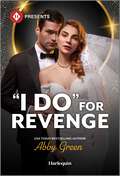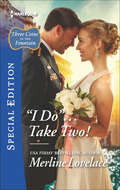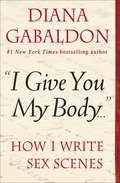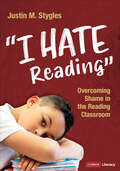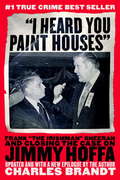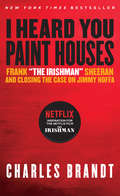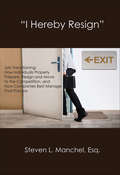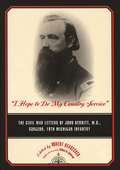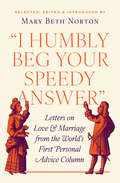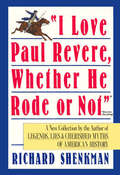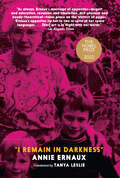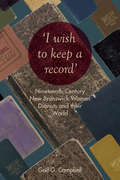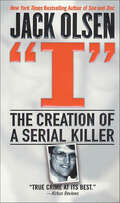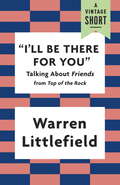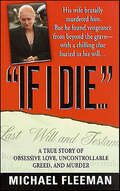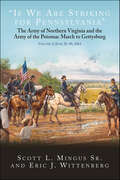- Table View
- List View
"I Do" for Revenge
by Abby GreenHe ruined her life…but is he also the key to her future? USA TODAY bestselling author Abby Green enthralls with this dramatic revenge romance! Jilted by the Italian…Still craving his touch! Vittorio Vitale is feeling victorious. The Gavia family destroyed his own; abandoning their niece Flora at the altar is the perfect payback. Then Flora bursts into his office, demanding answers! Her anger is startling—as is their sudden searing attraction. Except she leaves before it can be explored… Jilted then disinherited, Flora is waitressing to survive. Until Vittorio spots her and presents a new deal—a mutually beneficial fake relationship! A Vitale proposal burned Flora before…but with chemistry this strong, can she resist saying &“I do&” again?From Harlequin Presents: Escape to exotic locations where passion knows no bounds.
"I Do" . . . Take Two!: Take Two! (Three Coins in the Fountain #1)
by Merline LovelaceHER PERFECT ROMAN HOLIDAY A Roman reunion isn't on Kate Westbrook's itinerary when she arrives in Italy. After all, she's flying solo on the vacation she'd hoped to share with her soon-to-be-ex. But when Kate tosses a coin into the Trevi Fountain, her deepest wish-a second chance with her gorgeous pilot husband-might come true... Travis knows his dangerous missions broke up his marriage, but he's determined to win back his wife. How can Kate resist the magic and moonlight of Venice, followed by a passionate interlude in a sun-drenched Tuscan villa? Now, instead of dodging missiles, Travis faces a far more daunting challenge: proving to the woman he adores that their love is as enduring as the Eternal City itself.
"I Give You My Body . . .": How I Write Sex Scenes
by Diana GabaldonFor writers looking to make sure their next physical interlude on the page inspires readers to share the moment rather than to laugh at it, bestselling author Diana Gabaldon divulges the writing secrets behind the sex scenes in her wildly popular Outlander novels. "Ask me to your bed," he said. "I shall come to ye." In this revealing compendium, acclaimed writer Diana Gabaldon shares her invaluable lessons for creating an immersive reading experience, from evoking a mood to using the power of emotions to communicate physical intimacy. You'll learn the difference between gratuitous sex and genuine encounters that move the story forward, and how to handle less-than-savory acts that nevertheless serve a narrative purpose. Gabaldon also notes that sex can be conveyed instead of described. With such tips as "The Rule of Three" for involving the senses, handy lists of naughty euphemisms (with instructions for use), and Gabaldon's own examples from the Outlander novels, "I Give You My Body . . ." is a master class in writing to draw readers in and keep them riveted to the page.
"I Give You My Body . . .": How I Write Sex Scenes
by Diana GabaldonFor writers looking to make sure their next physical interlude on the page inspires readers to share the moment rather than to laugh at it, bestselling author Diana Gabaldon divulges the writing secrets behind the sex scenes in her wildly popular Outlander novels. "Ask me to your bed," he said. "I shall come to ye." In this revealing compendium, acclaimed writer Diana Gabaldon shares her invaluable lessons for creating an immersive reading experience, from evoking a mood to using the power of emotions to communicate physical intimacy. You'll learn the difference between gratuitous sex and genuine encounters that move the story forward, and how to handle less-than-savory acts that nevertheless serve a narrative purpose. Gabaldon also notes that sex can be conveyed instead of described. With such tips as "The Rule of Three" for involving the senses, handy lists of naughty euphemisms (with instructions for use), and Gabaldon's own examples from the Outlander novels, "I Give You My Body . . ." is a master class in writing to draw readers in and keep them riveted to the page.
"I Had To Run Away": The Imprisonment of Women and Girls for "Moral Crimes" in Afghanistan
by Human Rights WatchThis 120-page report is based on 58 interviews conducted in three prisons and three juvenile detention facilities with women and girls accused of "moral crimes." Almost all girls in juvenile detention in Afghanistan had been arrested for "moral crimes," while about half of women in Afghan prisons were arrested on these charges. These "crimes" usually involve flight from unlawful forced marriage or domestic violence. Some women and girls have been convicted of zina, sex outside of marriage, after being raped or forced into prostitution. The fall of the Taliban government in 2001 promised a new era of women's rights. Significant improvements have occurred in education, maternal mortality, employment, and the role of women in public life and governance. Yet the imprisonment of women and girls for "moral crimes" is just one sign of the difficult present and worrying future faced by Afghan women and girls as the international community moves to decrease substantially its commitments in Afghanistan.
"I Hate Reading": Overcoming Shame in the Reading Classroom (Corwin Literacy)
by Justin M. StyglesIt can take a lifetime to eradicate a reader’s shame—or it can take one great teacher Shame-bound readers want someone to notice them. It’s true. But then what does a teacher do to help students? Justin Stygles found fresh answers in Gershen Kaufman’s seminal research on shame and applied it to his teaching. The results proved to him—and now us—that building relationships and taking deliberate actions to alleviate shame is crucial. With this remarkable book, Stygles shows us how to build an interpersonal bridge with students and make vulnerability okay. But make no mistake—disengaged readers need to feel competent before they fully buy in, and so the author packs the book with powerful instructional ideas. Learn to: Spot all the distress signals, including withdrawal, perfectionism, and compliance. Help students see that they are not permanently locked out of a reading life Use assessment instruments to note and celebrate incremental change Plan mini-units that develop skills in concert with engagement Design small group experiences that are free of levels and other shame-inducing labels Pump up independent reading with scaffolding and sociability Harness writing about reading to convince students of their uniqueness. The shame factor is real. It’s time we meet it head on, with innovation and the best thinking from multiple research fields. I Hate Reading is the tool that does just that.
"I Hate Reading": Overcoming Shame in the Reading Classroom (Corwin Literacy)
by Justin M. StyglesIt can take a lifetime to eradicate a reader’s shame—or it can take one great teacher Shame-bound readers want someone to notice them. It’s true. But then what does a teacher do to help students? Justin Stygles found fresh answers in Gershen Kaufman’s seminal research on shame and applied it to his teaching. The results proved to him—and now us—that building relationships and taking deliberate actions to alleviate shame is crucial. With this remarkable book, Stygles shows us how to build an interpersonal bridge with students and make vulnerability okay. But make no mistake—disengaged readers need to feel competent before they fully buy in, and so the author packs the book with powerful instructional ideas. Learn to: Spot all the distress signals, including withdrawal, perfectionism, and compliance. Help students see that they are not permanently locked out of a reading life Use assessment instruments to note and celebrate incremental change Plan mini-units that develop skills in concert with engagement Design small group experiences that are free of levels and other shame-inducing labels Pump up independent reading with scaffolding and sociability Harness writing about reading to convince students of their uniqueness. The shame factor is real. It’s time we meet it head on, with innovation and the best thinking from multiple research fields. I Hate Reading is the tool that does just that.
"I Hear America Singing": Folk Music and National Identity
by Rachel Clare DonaldsonFolk music is more than an idealized reminder of a simper past. It reveals a great deal about present-day understandings of community and belonging. It celebrates the shared traditions that define a group or nation. In America, folk music--from African American spirituals to English ballads and protest songs--renders the imagined community more tangible and comprises a critical component of our diverse national heritage. In "I Hear America Singing," Rachel Donaldson traces the vibrant history of the twentieth-century folk music revival from its origins in the 1930s through its end in the late 1960s. She investigates the relationship between the revival and concepts of nationalism, showing how key figures in the revival--including Pete Seeger , Alan Lomax, Moses Asch, and Ralph Rinzler--used songs to influence the ways in which Americans understood the values, the culture, and the people of their own nation. As Donaldson chronicles how cultural norms were shaped over the course of the mid-twentieth century, she underscores how various groups within the revival and their views shifted over time. "I Hear America Singing" provides a stirring account of how and why the revivalists sustained their culturally pluralist and politically democratic Americanism over this tumultuous period in American history.
"I Heard You Paint Houses"
by Charles Brandt"I Heard you Paint Houses" are the first words Jimmy Hoffa ever spoke to Frank "the Irishman" Sheeran. <P><P>To paint a house is to kill a man. The paint is the blood that splatters on the walls and floors. In the course of nearly five years of recorded interviews Frank Sheeran confessed to Charles Brandt that he handled more than twenty-five hits for the mob, and for his friend Hoffa. <P><P>Sheeran learned to kill in the U.S. Army, where he saw an astonishing 411 days of active combat duty in Italy during World War II. After returning home he became a hustler and hit man, working for legendary crime boss Russell Bufalino. <P><P>Eventually he would rise to a position of such prominence that in a RICO suit then-U.S. Attorney Rudy Giuliani would name him as one of only two non-Italians on a list of 26 top mob figures. When Bufalino ordered Sheeran to kill Hoffa, he did the deed, knowing that if he had refused he would have been killed himself. <P><P>Sheeran's important and fascinating story includes new information on other famous murders, and provides rare insight to a chapter in American history. Charles Brandt has written a page-turner that is destined to become a true crime classic. <P><P><b>A New York Times Bestseller</b>
"I Heard You Paint Houses", Updated Edition: Frank "The Irishman" Sheeran & Closing the Case on Jimmy Hoffa
by Charles BrandtUpdated with a 57-page Conclusion by the author that features new, independent corroboration of Frank Sheeran's revelations about the killing of Jimmy Hoffa, the killing of Joey Gallo and the murder of JFK, along with stories that could not be told before."I Heard You Paint Houses" will soon be a major motion picture directed by Martin Scorsese. The working title for the movie is "The Irishman".The first words Jimmy Hoffa ever spoke to Frank "the Irishman" Sheeran were, "I heard you paint houses." To paint a house is to kill a man. The paint is the blood that splatters on the walls and floors. In the course of nearly five years of recorded interviews Frank Sheeran confessed to Charles Brandt that he handled more than twenty-five hits for the mob, and for his friend Hoffa. Sheeran learned to kill in the U.S. Army, where he saw an astonishing 411 days of active combat duty in Italy during World War II. After returning home he became a hustler and hit man, working for legendary crime boss Russell Bufalino. Eventually he would rise to a position of such prominence that in a RICO suit then-U.S. Attorney Rudy Giuliani would name him as one of only two non-Italians on a list of 26 top mob figures. When Bufalino ordered Sheeran to kill Hoffa, he did the deed, knowing that if he had refused he would have been killed himself. Sheeran's important and fascinating story includes new information on other famous murders including those of Joey Gallo and JFK, and provides rare insight to a chapter in American history. Charles Brandt has written a page-turner that has become a true crime classic.From the Trade Paperback edition.
"I Hereby Resign": Job Transitioning: How Individuals Properly Prepare, Resign And Move To The Competition, And How Companies Best Manage That Proc
by Steven L. ManchelA concise, practical guide to problem-free job transitions for employees, recruiters, and business leaders: “Incredibly user-friendly.” —James B. Adelman, Esq., Senior Vice President, General Counsel, Commonwealth Financial NetworkThe fundamental purpose of this book is to provide a useful how-to guide for people who are deciding whether to leave their current employer and join a direct competitor, and for companies involved in the hiring and recruiting process. Many employees are subject to so-called Non-Competition Agreements and, consequently, already understand that there are significant risks, legal and business, when transitioning jobs. However, what most do not appreciate is that there are a host of laws and protocols, having nothing to do with whether an employment contract exists, that govern the way one may properly prepare to leave and the manner in which the hiring company can bring the new hire on board. Every year millions voluntarily leave their companies to join a direct competitor and millions more explore the possibility. All such undertakings, even if the ultimate decision is not to leave, bring legal and litigation and business risks—risks that can result in large damage awards, injunction orders, and general corporate disruption and turmoil. This book by an experienced attorney offers important guidance and practical tips on avoiding and minimizing those risks.“This book should find its way to the desk of anyone who is contemplating a transition to a competing firm, now or in the future. It is also a ‘must-read’ for all organizations involved in lateral hiring, as it explains the ‘do’s’ and ‘don’ts’ of talent acquisition.” —Boris Groysberg, Richard P. Chapman Professor of Business Administration at Harvard Business School
"I Hope to Do My Country Service": The Civil War Letters of John Bennitt, M.D., Surgeon, 19th Michigan Infantry
by William M. Anderson Robert BeaseckerIn 1862 at the age of thirty-two, Centreville, Michigan, physician John Bennitt joined the 19th Michigan Infantry Regiment as an assistant surgeon and remained in military service for the rest of the war. During this time Bennitt wrote more than two hundred letters home to his wife and daughters sharing his careful and detailed observations of army life, his medical trials in the field and army hospitals, dramatic battles, and character sketches of the many people he encountered, including his regimental comrades, captured Confederates, and local citizens in southern towns. Bennitt writes about the war's progress on both the battlefield and the home front, and also reveals his changing view of slavery and race.Bennitt traces the history of the 19th Michigan Infantry, from its mustering in Dowagiac in August 1862, its duty in Kentucky and Tennessee, its capture and imprisonment by Confederate forces, its subsequent exchange and reorganization, its participation in the Atlanta and the Carolinas campaigns, its place in the Grand Review in Washington, and the final mustering out in Detroit in June 1865. John Bennitt's significant collection of letters sheds light not only on the Civil War but on the many aspects of life in a small Michigan town. Although a number of memoirs from Civil War surgeons have been published in the last decade, "I Hope to Do My Country Service" is the first of its kind from a Michigan regimental surgeon to appear in more than a century.
"I Humbly Beg Your Speedy Answer": Letters on Love and Marriage from the World’s First Personal Advice Column
by Mary Beth NortonA fascinating collection of questions and answers—about courtship, marriage, love, and sex—from a seventeenth-century periodical The Athenian Mercury—a one-page, two-sided periodical published in 1690s London—included the world&’s first personal advice column. Acclaimed historian and Pulitzer Prize–finalist Mary Beth Norton&’s &“I Humbly Beg Your Speedy Answer&” is a remarkable collection of questions and answers drawn from this groundbreaking publication.In these exchanges, anonymous readers look for help with their most intimate romantic problems—about courting, picking a spouse, getting married, securing or avoiding parental consent, engaging in premarital sex and extramarital affairs, and much more. Spouses ask how to handle contentious marriages and tense relationships with in-laws. Some correspondents seek ways to ease a conscience troubled by romantic and sexual misbehavior. The lonely wonder how to meet a potential partner—or how to spark a warmer relationship with someone they already have an eye on. And both men and women inquire about how to extract themselves from relationships turned sour. Many of these concerns will be familiar to readers of today&’s advice columns. But others are delightfully strange and surprising, reflecting forgotten social and romantic customs and using charmingly unfamiliar language in which, for example, &“kissing is a luscious diet,&” a marriage might provide &“much love and moderate conveniency,&” and an &“amorous disposition&” can lead to trouble.Delightful and entertaining, &“I Humbly Beg Your Speedy Answer&” provides a unique, intriguing, and revealing picture of what has—and hasn&’t—changed over the past three centuries when it comes to love, sex, and relationships.
"I Love Paul Revere, Whether He Rode Or Not"
by Richard ShenkmanProvocative and amusingly heretical, "I Love Paul Revere, Whether He Rode or Not" (a quote attributed to Warren Harding) offers eye-opening revelations debunking long-held American legends.
"I Love Paul Revere, Whether He Rode Or Not": A Collection of Legends, Lies, & Cherished Myths of American
by Richard ShenkmanProvocative and amusingly heretical, "I Love Paul Revere, Whether He Rode or Not" (a quote attributed to Warren Harding) offers eye-opening revelations debunking long-held American legends.
"I Remain in Darkness"
by Annie ErnauxAn extraordinary evocation of a grown daughter’s attachment to her mother, and of both women’s strength and resiliency. "I Remain in Darkness" recounts Annie’s attempts first to help her mother recover from Alzheimer’s disease, and then, when that proves futile, to bear witness to the older woman’s gradual decline and her own experience as a daughter losing a beloved parent. "I Remain in Darkness" is a new high water mark for Ernaux, surging with raw emotional power and her sublime ability to use language to apprehend her own life’s particular music.
"I wish to keep a record": Nineteenth-Century New Brunswick Women Diarists and Their World
by Gail CampbellNineteenth-century New Brunswick society was dominated by white, Protestant, Anglophone men. Yet, during this time of state formation in Canada, women increasingly helped to define and shape a provincial outlook. I wish to keep a record is the first book to focus exclusively on the life-course experiences of nineteenth-century New Brunswick women. Gail G. Campbell offers an interpretive scholarly analysis of 28 women’s diaries while enticing readers to listen to the voices of the diarists. Their diaries show women constructing themselves as individuals, assuming their essential place in building families and communities, and shaping their society by directing its outward gaze and envisioning its future. Campbell’s lively analysis calls on scholars to distinguish between immigrant and native-born women and to move beyond present-day conceptions of such women’s world. This unique study provides a framework for developing an understanding of women's worlds in nineteenth-century North America.
"I": The Creation of a Serial Killer
by Jack OlsenThe prize-winning, bestselling journalist provides a fascinating glimpse into the mind of “The Happy Face Killer” in the serial murderer’s own words . . .In February 1990, Oregon State Police arrested John Sosnovke and Laverne Pavlinac for the vicious rape and murder of Taunja Bennet, a troubled twenty-three-year-old barfly who had a mild intellectual disability since birth. There was just one problem. They had the wrong people.And the real killer wasn’t about to let anyone take credit for his kill. Keith Hunter Jesperson was a long-haul truck driver and the murderer of eight women, including Taunja Bennet. As the case wound through police precincts and courts—ending in life sentences for both Sosnovke and Pavlinac—Jesperson began a twisted one-man campaign to win their release. To the editors of newspapers and on the walls of highway rest stops, Jesperson scribbled out a series of taunting confessions. At the end of each admission, Jesperson drew a happy face, earning for himself the grisly sobriquet “The Happy Face Killer.”Based on access to interviews, diaries, court records, and the criminal himself, I: The Creation of a Serial Killer is Jesperson’s chilling story. It chronicles his evolution from angry child to sociopathic murderer, from tormentor of animals to torturer of women. It is also the story of the fate that befell him after two innocent citizens were imprisoned four years for one of his killings.In I: The Creation of a Serial Killer, Edgar Award winner Jack Olsen lets Jesperson tell his story in his own words, offering unprecedented insight into the twisted thought process of a serial murderer.
"I'll Be There for You"
by Warren LittlefieldAn eBook short.A behind-the-scenes look at Friends, one of the most popular TV shows of all time--a wide-ranging interview with the cast and creators, excerpted from Top of the Rock, by former NBC President of Entertainment Warren LittlefieldIt was a little show originally called Six of One, whose pilot only tested decently with audiences--but all of that would soon change. "I'll Be There for You" presents a colorful, funny, and enlightening oral history drawn from the actors and creators of Friends. Outlining the whole history of the show, from first episode to last, including testimonials straight from the studio floor, this selection reveals the personal side of the "Shakespearean soap opera," including how the actors dealt with fame, helped to create their roles, negotiated and grew together as one family, and (of course) how Joey became Joey.
"I'm Not a Racist, But . . .": The Moral Quandary of Race
by Lawrence BlumNot all racial incidents are racist incidents, Lawrence Blum says. "We need a more varied and nuanced moral vocabulary for talking about the arena of race. We should not be faced with a choice of 'racism' or nothing." Use of the word "racism" is pervasive: An article about the NAACP's criticism of television networks for casting too few "minority" actors in lead roles asks, "Is television a racist institution?" A white girl in Virginia says it is racist for her African-American teacher to wear African attire. Blum argues that a growing tendency to castigate as "racism" everything that goes wrong in the racial domain reduces the term's power to evoke moral outrage. In "I'm Not a Racist, But . . .", Blum develops a historically grounded account of racism as the deeply morally-charged notion it has become. He addresses the question whether people of color can be racist, defines types of racism, and identifies debased and inappropriate usages of the term. Though racial insensitivity, racial anxiety, racial ignorance and racial injustice are, in his view, not "racism," they are racial ills that should elicit moral concern. Blum argues that "race" itself, even when not serving distinct racial malfeasance, is a morally destructive idea, implying moral distance and unequal worth. History and genetic science reveal both the avoidability and the falsity of the idea of race. Blum argues that we can give up the idea of race, but must recognize that racial groups' historical and social experience has been shaped by having been treated as if they were races.
"I'm, Like, SO Fat!"
by Dianne Neumark-SztainerIt's hard to decide which is more frightening the "food" teenagers enjoy, or the things they say about their bodies. Whether it's your son's passion for chips and soda or your daughter's announcement that she "feels fat," kids' attitude about how they look and what they should eat often seem devoid of common sense. In a world where television and school cafeterias push super-sized sandwiches while magazines feature pencil-thin models, many teens feel pressured to starve themselves and others eat way too much. Blending her experience as the mother of four with results from a survey of nearly 5,000 teens, Dr. Diane Neumark-Sztainer shows you how to respond constructively to "fat talk," counteract negative media messages, and give your kids the straight story about nutrition and calories, the dangers of dieting, and eating right when they're away from home. Full of examples illustrating the challenges teens face today, this upbeat and insightful book is packed with great ideas that will help kids everywhere feel better about their looks and make healthier choices about eating and exercise.
"If I Die . . .": A True Story of Obsessive Love, Uncontrollable Greed, and Murder (St. Martin's True Crime Library)
by Michael FleemanHe'd been shot in the head, decapitated, and set on fire. Who could have turned on the real-estate ace with such bloodthirsty fury? Even before the remains were found, circumstantial evidence was building against Rudin's 52-year-old wife, Margaret, who stood to inherit a handsome share of her husband's fortune. Rudin's friends also suspected Margaret, and the victim has thought that his wife was trying to poison him when he was alive. Then a chilling caveat was discovered in Rudin's living trust: should he die under violent circumstances, an investigation should be conducted. By the time authorities closed in on Margaret Rudin she'd disappeared. It would take two and a half years to hunt the Black Widow down, and to discover the secrets at the heart of poisonous marriage...Now, reporter Michael Fleeman delivers a startling glimpse into the mind of a woman who would stop at nothing to get what she wanted. Fleeman also details the relentless pursuit of justice that would lead authorities from the glamorous facade of Las Vegas to a squalid apartment on the outskirts of Boston, to hold the remorseless wife accountable for her shocking crimes.
"If We Are Striking for Pennsylvania", Volume 2: The Army of Northern Virginia and the Army of the Potomac March to Gettysburg
by Eric J. Wittenberg Scott L. Mingus Sr.Award-winning authors Scott L. Mingus Sr. and Eric J. Wittenberg are back with the second and final installment of “If We Are Striking for Pennsylvania”: The Army of Northern Virginia’s and Army of the Potomac’s March to Gettysburg. This compelling and bestselling study is the first to fully integrate the military, political, social, economic, and civilian perspectives with rank-and-file accounts from the soldiers of both armies during the inexorably march north toward their mutual destinies at Gettysburg. Gen. Robert E. Lee’s bold movement north, which began on June 3, shifted the war out of the central counties of the Old Dominion into the Shenandoah Valley, across the Potomac, and beyond. The first installment (June 3-22, 1863) carried the armies through the defining mounted clash at Battle of Brandy Station, after which Lee pushed his corps into the Shenandoah Valley and achieved the magnificent victory at Second Winchester on his way to the Potomac. Caught flat-footed, Maj. Gen. Joseph Hooker used his cavalry to probe the mountain gaps, triggering a series of consequential mounted actions. The current volume (June 23-30) completes the march to Gettysburg and details the actions and whereabout of each component of the armies up to the eve of the fighting. The large-scale maneuvering in late June prompted General Hooker to move his Army of the Potomac north after his opponent and eventually above the Potomac, where he loses his command to the surprised Maj. Gen. George G. Meade. Jeb Stuart begins his controversial and consequential ride that strips away the eyes and ears of the Virginia army. Throughout northern Virginia, central Maryland, and south-central Pennsylvania, civilians and soldiers alike struggle with the reality of a mobile campaign and the massive logistical needs of the armies. Untold numbers of reports, editorials, news articles, letters, and diaries describe the passage of the long martial columns, the thunderous galloping of hooves, and the looting, fighting, suffering, and dying. Mingus and Wittenberg mined hundreds of primary accounts, newspapers, and other sources to produce this powerful and gripping saga. As careful readers will quickly discern, other studies of the runup to Gettysburg gloss over most of this material. It is simply impossible to fully grasp and understand the campaign without a firm appreciation of what the armies and the civilians did during the days leading up to the fateful meeting at the small crossroads town in Adams County, Pennsylvania.
"If We Return, We Will Be Killed": Consolidation of Ethnic Cleansing in Darfur, Sudan
by Human Rights WatchSince February 2003, in the context of a military counter-insurgency campaign against two rebel groups, the Sudan Liberation Army (SLA) and the Justice and Equality Movement (JEM) Sudanese government forces and government-backed ethnic militias known as "Janjaweed" have committed war crimes, crimes against humanity and "ethnic cleansing" in the Darfur region of Sudan. Government forces and militias have systematically targeted civilian communities that share the same ethnicity as the rebel groups, killing, looting, raping, forcibly displacing and destroying hundreds of villages. For their part, the rebel groups have abducted civilians, attacked police stations and other government institutions, and raided and looted substantial numbers of livestock and commercial goods from trucks and vehicles traveling on roads in Darfur. The rebels have also been responsible for some direct and indiscriminate attacks that have resulted in deaths and injuries to civilians and for the use of child soldiers. This report documents and analyzes the continuing violence by all parties to the conflict, obstacles to return and to the reversal of ethnic cleansing, the government's efforts to end impunity and the international community's response so far to the ongoing human rights crisis in Darfur.
"If You Love Me, You Will Do My Will": The Stranger-Than-Fiction Saga of a Trappist Monk, a Texas Widow, and Her Half-Billion-Dollar Fortune
by Stephen G. Michaud Hugh AynesworthSome images in this ebook are not displayed owing to permissions issues.
